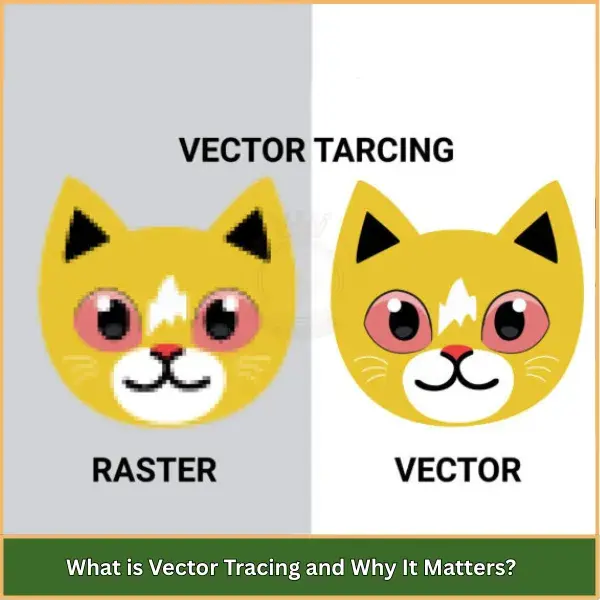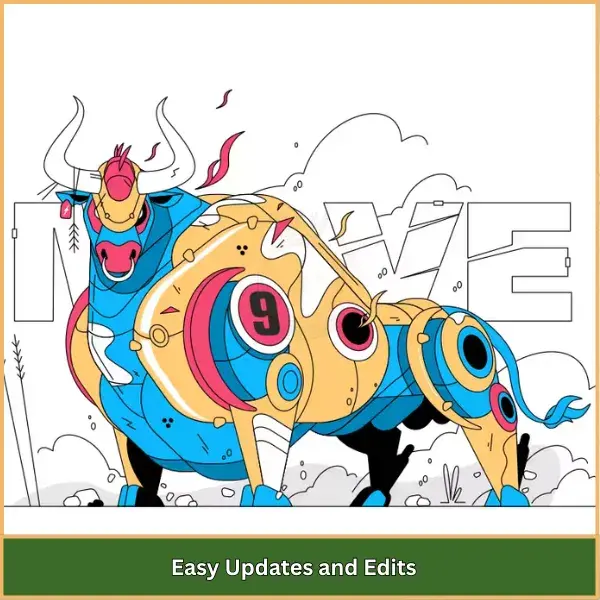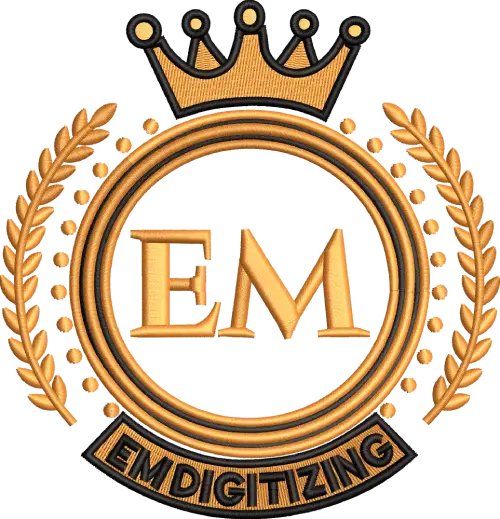Avez-vous déjà imprimé votre logo et remarqué qu'il avait l'air flou, déchiqueté, ou tout simplement pas aussi professionnel que vous l'imaginiez? C'est là traçage vectoriel entre. C'est le processus qui garantit que votre logo semble clair s'il est imprimé sur une petite carte de visite ou étiré sur un panneau d'affichage massif.

Sans ça, L'image de votre marque peut perdre sa netteté, Ce qui peut nuire à votre look professionnel. Dans cet article, Nous allons explorer pourquoi cette étape est essentielle, les problèmes qu'il résout, Et comment il garantit des résultats parfaits chaque fois que vous utilisez votre logo
Comment le traçage des vecteurs rend votre logo d'entreprise parfait sur tout?
Qu'est-ce que le traçage des vecteurs et pourquoi c'est important?

C'est le processus de conversion d'un pixel (raster) image comme un JPG ou une PNG dans un propre, format vectoriel évolutif comme l'IA, PSE, ou svg.
La principale différence réside dans la façon dont l'image est construite:
- Images raster sont composés de minuscules pixels.
- Images vectorielles sont construits à partir de chemins, points, et formes basées sur des formules mathématiques.
Cela signifie que les images vectorize peuvent être redimensionnées infiniment sans perdre de netteté ou de qualité, les rendre parfaits pour l'impression, broderie, signalisation, et utilisation numérique.
Cette conversion peut être effectuée avec des outils comme un convertisseur d'image vectoriel ou Logiciel de traçage vectoriel, Mais pour les meilleurs résultats, Un concepteur qualifié retrace manuellement l'image pour la précision et la précision.
Problèmes causés par les logos non vectoriels
Les logos non vectoriels peuvent créer de nombreux problèmes pour votre marque, surtout dans l'impression, broderie, et de grands écrans.
- Pixelation et bords flous: Quand un logo raster est agrandie, Il a l'air rugueux et peu clair car les pixels montrent. Cela rend le design non professionnel.
- Évolutivité limitée: Les fichiers raster ne peuvent être redimensionnés qu'un peu avant de perdre la qualité. Vous pouvez avoir besoin de nombreuses versions de logo, Mais aucun ne sera aussi net qu'un logo vectoriel.
- Incohérence des couleurs: Les logos raster peuvent afficher des couleurs légèrement différentes lorsqu'elles sont imprimées sur différents matériaux. Cela peut rendre les couleurs de votre marque inégales.
- Difficile à modifier: Changement de formes, texte, ou les couleurs dans un logo raster sont difficiles et peuvent réduire la qualité. Souvent, Le logo doit être complètement redessiné.
7 Avantages clés du traçage des vecteurs pour votre logo
La conversion de votre logo en format vectoriel est plus que d'améliorer la clarté de l'image, il s'agit de rendre votre marque flexible, adaptable, et prêt à l'avenir.

Voici les sept raisons les plus importantes pour art vectoriel est essentiel pour toute entreprise sérieuse.
- Évolutivité parfaite
- Toujours net et clair
- Mises à jour et modifications faciles
- Plus petit, Taille de fichier plus efficace
- Fonctionne avec toutes les méthodes de production modernes
- Cohérence sur toutes les plateformes
- Apparence professionnelle et valeur à long terme
1. Évolutivité parfaite
Avec Images de traçage vectoriel, Votre logo peut être redimensionné pour s'adapter à tout, De la plus petite étiquette de produit à un panneau d'affichage géant, sans perdre la netteté. Contrairement aux images raster qui se séparent et ont l'air pixélisées lors de l'agrandissement, Les fichiers vectoriels gardent chaque courbe et chaque bord parfaitement croustillant.
Cette évolutivité signifie que vous n'avez pas à créer plusieurs versions de votre logo pour différentes utilisations, Assurer la cohérence et gagner du temps.
2. Toujours net et clair

Une image de marque professionnelle dépend de la clarté. Si votre logo est brodé sur une chemise, imprimé dans une brochure, ou affiché sur un site Web haute résolution, Un logo vectoriel maintient des bords lisses et des détails précis.
Cette netteté donne aux clients l'impression de professionnalisme et de haute qualité, quelque chose qui renforce la confiance et la crédibilité de la marque.
3. Mises à jour et modifications faciles

Les marques évoluent avec le temps, Et aussi leurs éléments visuels. Avec Tracage du vecteur illustratrice, Vous pouvez facilement mettre à jour votre logo sans compromettre la qualité. Veux changer une couleur, Ajouter une touche saisonnière, ou ajuster la police? C'est rapide, Facile, et non destructif.
Cette flexibilité vous permet de garder votre marque fraîche sans avoir besoin de refonte coûteuse ou de partir de zéro.
4. Plus petit, Taille de fichier plus efficace
Les fichiers raster haute résolution peuvent être très importants, Ralentir votre flux de travail. Ils prennent plus de temps à télécharger sur les sites Web, sont plus difficiles à envoyer par e-mail, et peut même provoquer des retards d'impression.
Fichiers vectoriels, toutefois, sont légers tout en conservant une qualité parfaite. Cela les rend plus faciles à stocker, partager, et envoyer, accélérer à la fois vos processus de marketing et de production.
5. Fonctionne avec toutes les méthodes de production modernes

La marque d'aujourd'hui va au-delà de l'impression et du numérique, Vous pourriez avoir besoin de votre logo pour la broderie, coupure laser, gravure, imprimerie en vinyle, ou même l'impression 3D. Ces processus nécessitent une précision, ce qui n'est possible qu'avec des lignes vectorielles propres.
Utilisant un convertisseur de fichiers vectoriel ou le traçage manuel professionnel garantit que votre logo est compatible avec chaque méthode de production, réduire les erreurs coûteuses et garantir que le produit final semble exactement comme prévu.
6. Cohérence sur toutes les plateformes
Votre identité de marque doit se ressembler, peu importe où il est affiché, que ce soit sur l'emballage, réseaux sociaux, cartes de visite, ou signalisation. Un fichier vectoriel maintient les couleurs, proportions, et façonne uniforme sur chaque médium. Cette cohérence visuelle renforce votre reconnaissance de marque et aide votre entreprise à paraître plus polie et professionnelle.
7. Apparence professionnelle et valeur à long terme
Un nettoyage, Le logo bien tracé communique l'attention aux détails et au professionnalisme. Cela rend votre marque organisée, digne de confiance, et de haute qualité. En même temps, Les fichiers vectoriels sont à l'épreuve des futurs, ce qui signifie qu'ils resteront compatibles avec les nouvelles technologies et formats pour les années à venir.
Plus, avec un fichier vectoriel universel, vous pouvez utiliser le même motif Dans tous les matériaux de marque, réduire les maux de tête de gestion des fichiers et éviter les coûts de conversion répétés.
Utilisations du traçage vectoriel dans les affaires
Il est largement utilisé dans différents domaines d'activité où, pointu, et un logo ou des illustrations évolutifs est nécessaire.
- Marketing imprimé: Brochures, cartes de visite, dépliants, affiches, et des bannières.
- Emballage de produit: Étiquettes, boîtes, et tags avec des logos de marque clairs.
- Vêtements et uniformes: Pour la broderie, impression d'écran, et transfert de chaleur.
- Signalisation et panneaux d'affichage: Affichage net et clair à grande taille.
- Médias numériques: Sites Web, graphiques de médias sociaux, et des publicités en ligne.
- Articles promotionnels: Tasses, des stylos, sacs fourre-tout, et d'autres cadeaux.
Production spécialisée: Gravure laser, coupure de vinyle, et l'impression 3D.
Conclusion
Votre logo est le visage de votre marque, et il doit toujours sembler vif et professionnel, peu importe où il est utilisé. Avec traçage vectoriel, Vous pouvez vous assurer que votre logo reste net et clair s'il est imprimé sur une carte de visite, brodé sur un uniforme, ou affiché sur un panneau d'affichage géant.
Il vous donne la flexibilité de redimensionner votre logo sans perdre la qualité, Garde cohérent les couleurs de votre marque, et facilite l'édition chaque fois que vous souhaitez mettre à jour votre conception.
À Numérisation EM$, Nous créons des fichiers vectoriels de haute qualité avec soin et précision, s'assurer qu'ils fonctionnent parfaitement pour l'impression, broderie, signalisation, ou toute autre utilisation professionnelle. Nous nous concentrons sur les détails afin que votre logo soit le meilleur dans chaque format.
Tout de suite, nous offrons 50% de réduction sur votre première commande, Vous pouvez donc voir la qualité par vous-même. Donnez à votre marque la touche professionnelle qu'elle mérite et laissez Numérisation EM Préparez un logo qui est prêt pour tout.Commandez maintenant Et faire ressortir votre marque partout.
FAQ
Les concepteurs préfèrent les graphiques vectoriels pour les logos car ils peuvent être redimensionnés sans perdre la netteté. Ils facilitent également l'ajustement des formes, couleurs, ou texte, qui maintient le logo adaptable aux futurs besoins de marque.
Quand l'impression, Un logo vectoriel vous donne un résultat net et professionnel à n'importe quelle taille. Les logos basés sur les pixels peuvent avoir l'air flou ou un blocage lorsqu'ils sont agrandis, ce qui peut endommager la qualité visuelle de votre marque.
Le plus grand avantage est que les fichiers vectoriels restent parfaitement clairs, Qu'il soit imprimé petit ou énorme. Ils facilitent également les imprimantes de correspondre plus facilement aux couleurs de votre marque, ce qui aide à garder votre identité cohérente.
Un logo vectoriel garantit que votre marque est la même partout - des petites marchandises aux signes extérieurs massifs. Il maintient les détails pointus et les couleurs cohérentes, Rendre votre marque polie et fiable.
